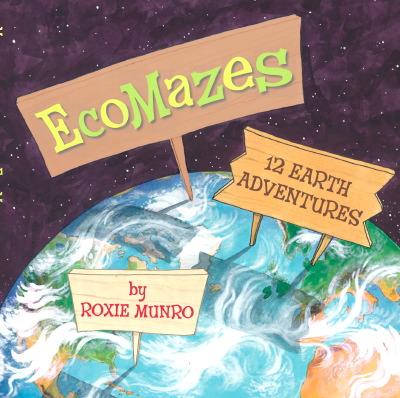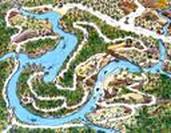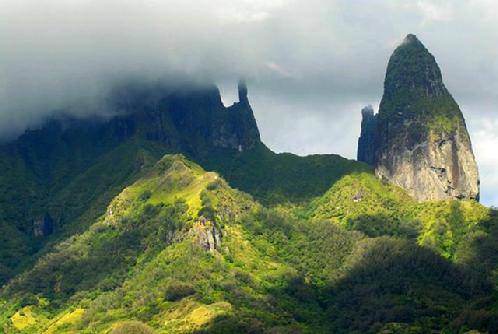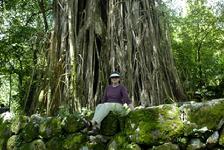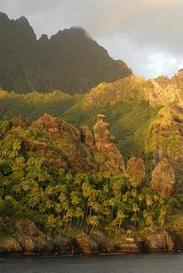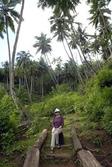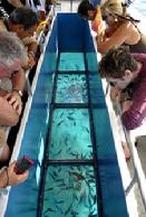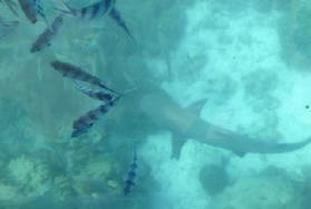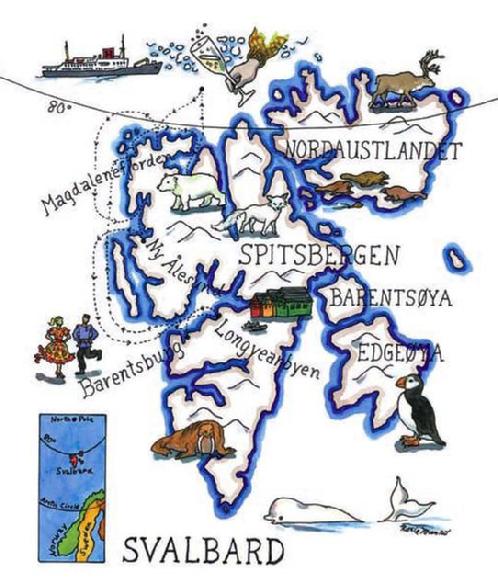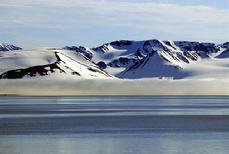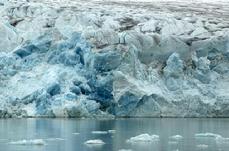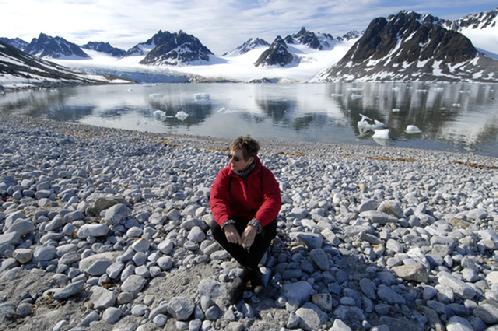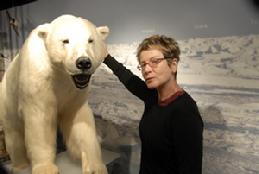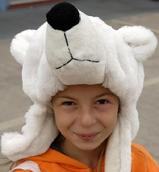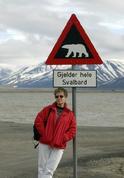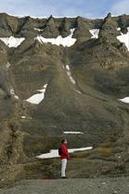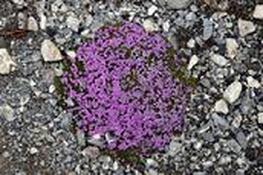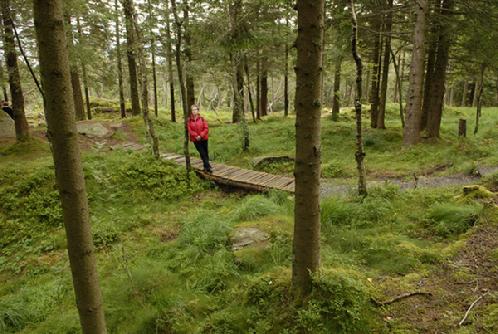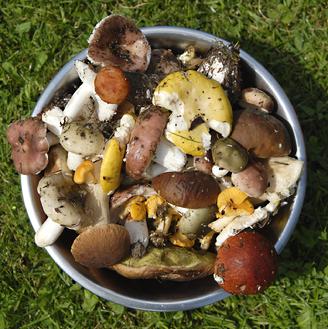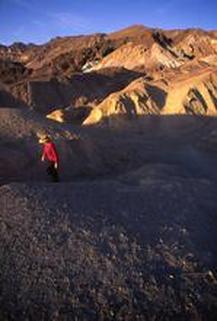For reviews of EcoMazes: 12 Earth Adventures, go to Books/Reviews
|
Most of my ideas develop out of previous work, and EcoMazes: 12 Earth Adventures is no exception. In the preceding maze book, Mazeways: A to Z, for the letter J, I had created a Jungle maze. Not long after the book was published, looking it over, I realized that it would be cool to do a rainforest maze. And, then, why not do other ecosystems - a whole book? The title, EcoMazes, seemed perfect.
|
My Swedish husband, Bo Zaunders, is a travel writer and photographer. He had assignments that year in the Marquesas Islands (French Polynesia) and Norway (Svalbard, islands above the Arctic Circle). Great for EcoMazes research!
So off we went to the Marquesas, traveling on a half cargo/half passenger freighter for two weeks, visiting the 6 inhabited (of 12) islands. They are just south of the Equator, and farther away from a continental landfall than any other group of islands on earth - as far as you can get from so-called civilization.
So off we went to the Marquesas, traveling on a half cargo/half passenger freighter for two weeks, visiting the 6 inhabited (of 12) islands. They are just south of the Equator, and farther away from a continental landfall than any other group of islands on earth - as far as you can get from so-called civilization.
|
Because they are so rugged, with few beaches, there is almost no tourism - nor hotels, restaurants, and not even a lot of roads. There is only one airstrip in all the islands, with rare flights. Every three weeks the ship Aranui III brings all food, mail, and other goods (off-loading cars, oil, clothing, soft drinks, toilet paper, everything) to the small populace.
|
|
Unless there was a dock, we took whaleboats from the ship to the shore of an island, and then would tramp off through the woods, or take a jeep to the higher mountains or the other side of the island, often stopping for a picnic. We saw huge banyan trees, walked through lush rainforests, and climbed the less rugged hills. We saw porpoises and manta rays. We heard exotic-sounding bird calls. We dodged tropical downpours and saw lots of rainbows. There was a naturalist along, to teach us about the rainforest in daily lectures.
|
After visiting the Marquesas, we stopped off at the Rangiroa atolls near Tahiti, checked out colorful fish swimming under the pier, walked along the beach, and took a trip in a glass-bottomed boat, where we saw lots of brightly colored fish in the coral reefs, and even a shark!
A couple months later we flew from NYC to Oslo, and then took three more flights, in progressively smaller airplanes, to the Svalbard islands, halfway between the top of the Norwegian mainland and the North Pole. There we were meeting up, also for two weeks, with a Hurtigruten ship, also with a history of mail and cargo delivery to places inaccessible by road or planes.
|
Again, we took daily excursions from the ship, usually by small tender boats, into the ice-bound fjords, with glaciers tumbling down to the sea. It is quite extraordinary to stand in the cold crisp silent Arctic air, and hear the sudden crack of a calving glacier in the near distance. These large pieces of ice breaking off from glaciers and crashing into the sea are becoming more and more common, both here and in the Antarctic, because of global warming. |
Everyone loves polar bears. There used to be many more polar bears in these islands, but they were hunted for sport, meat, and their fur. Now they are protected. However, there are more polar bears, about 3,000, than people in Svalbard. Here I am, later, in a Norwegian Museum with one (harmless, though). And there are little polar bear fans too...
|
We saw two polar bears - one walking on all fours along the coast and also one swimming. They have
no experience with humans; polar bears have attacked and killed people in Svalbard. You are warned not to walk outside of the couple of small towns we visited, and while exploring, to always stay within a few yards of the rest of the group. Our guides all carried loaded rifles. |
|
Especially memorable was the time we spent walking along the frozen tundra. No snow there - just rocks and pebbles, a barren landscape - no trees, little water, not much animal life. There were beautiful little clusters of tiny flowers, huddled together in a circular pattern, grasping for life among the icy pebbles and rocks. And multi-colored lichen...looking like an artist spilled paint on the rocks
|
After Norway we headed down to Southern Sweden, land of lakes and conifer forests, to visit family. There, I set out each morning with my brother-in-law on a mushroom hunt in the woods. We would walk along, mostly silent, accompanied by his golden retriever, looking for mushrooms, of which this part of Sweden has a huge variety. There is nothing like walking quietly along, and, out of the corner of your eye, spying the tell-tale tiny luminous orange cap of the precious chanterelle mushroom amid the pine needles, rocks, moss, and fallen branches deep in the pine forest. Here is one morning's bounty...
|
I have visited deserts (here, Death Valley), climbed Mount Whitney (an alpine area) in the Sierra Nevadas, and canoed along a bayou in the wetlands of Louisiana. I was raised in Southern Maryland, on the Chesapeake Bay, one of the great estuaries of the world, so I am intimately familiar with wetlands, marshes, and the creatures that live in such habitats. Because of a series of books on the West, I have spent a lot of time on ranches in west Texas, so the grassland idea in EcoMazes came easily. I taught sailing in a summer camp in Maine and owned a cabin next to the Monongahela National Forest in West Virginia - both in temperate deciduous forests.
|
Many of us have visited more ecosystems than we think we have - when I started this book, most of these earlier trips I did not remember, or think were relevant. But, while working on EcoMazes, and now, reflecting afterward, I realize that, although I do not consider myself a naturalist at all (I live quite happily smack in the middle of one of the largest cities in the world, with one house plant and a view out of my 10th floor window of a few ginko trees along the avenue) it is very important to me, and to all of us, to preserve, to conserve, to learn about - and to love - our wonderous earth, and all it contains.
